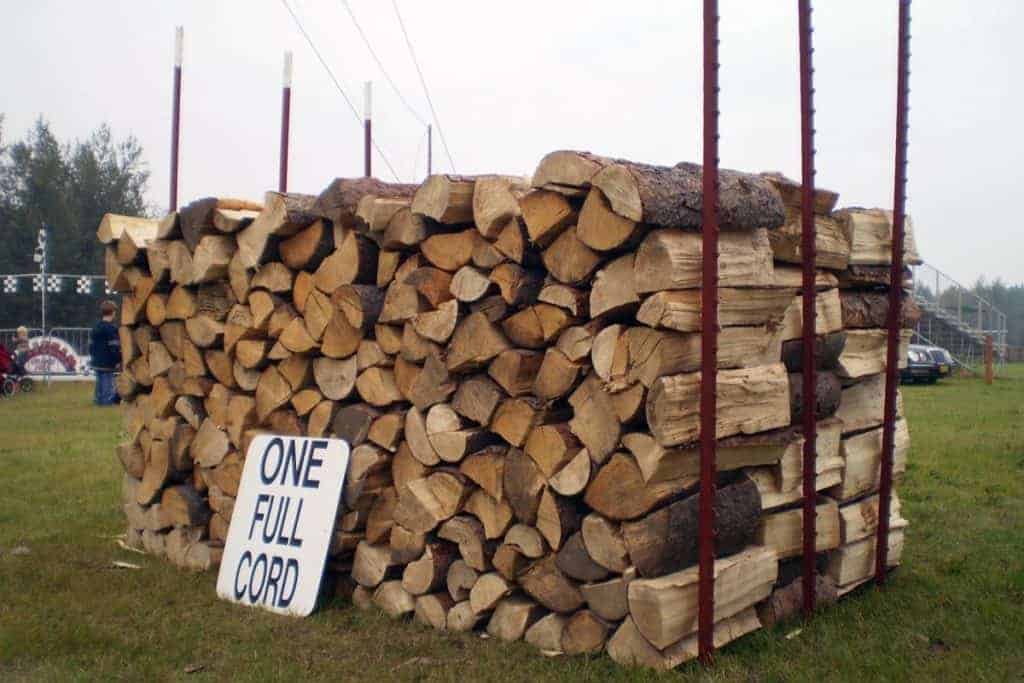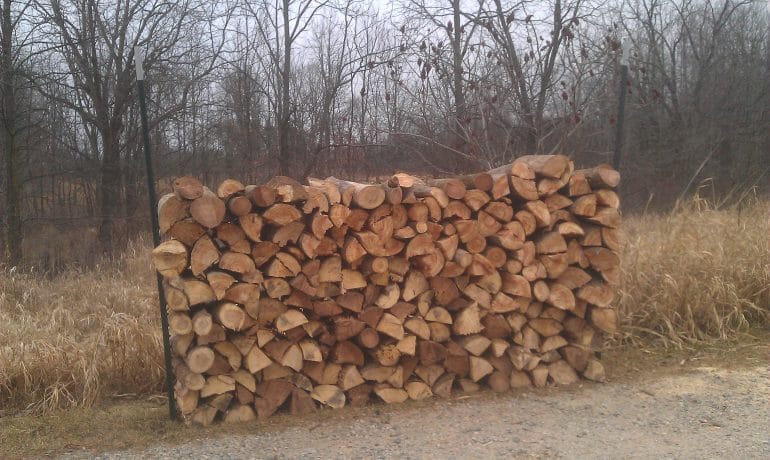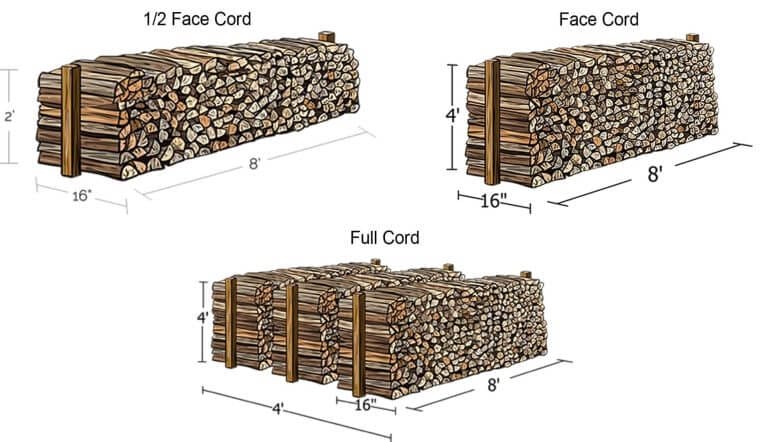A cord of wood is a standard unit of measurement for firewood, typically measuring 4 feet high, 4 feet wide, and 8 feet long. The number of bundles in a cord of wood can vary depending on the size and type of the bundles. However, on average, a cord of wood is equivalent to around 80 to 100 bundles, making it a substantial amount of firewood for heating or fireplace purposes.

Understanding Cord Measurements: Exploring the Relationship Between Bundles and Cords of Wood
Wood is a versatile and commonly used material that provides warmth and a natural aesthetic to our living spaces. Whether it’s for heating our homes or for recreational purposes such as campfires, having a good understanding of cord measurements is essential when purchasing firewood. In this section, we will delve into the intricacies of cord measurements, specifically exploring the relationship between bundles and cords of wood.

1. What is a Cord of Wood?
A cord is a standardized unit of measurement used to quantify the amount of firewood. It is defined as a tightly stacked pile of wood that measures 4 feet high, 4 feet wide, and 8 feet long. This results in a total volume of 128 cubic feet. A cord typically consists of various lengths of firewood, usually ranging from 16 to 18 inches long.
2. How is a Cord of Wood Sold?
When purchasing firewood, you may come across different terms such as “face cord” or “rick.” It’s essential to understand these terms to ensure you’re getting the right amount of firewood for your needs.
A full cord is the standard measurement and is equivalent to the 4 feet x 4 feet x 8 feet dimensions mentioned earlier. This is the most accurate and reliable measurement when it comes to purchasing firewood.
A face cord, on the other hand, is a smaller unit of measurement. It typically measures 4 feet high and 8 feet long but has a varying width. Face cords are commonly referred to as “stove cords” or “short cords.” The width of a face cord can vary depending on the length of the firewood. It is important to clarify the width of a face cord when purchasing to ensure you are getting the desired amount of firewood.
A rick is another term used to describe a smaller quantity of firewood. It is often used interchangeably with a face cord, but the dimensions can vary. A rick is generally a stack of firewood that measures 4 feet high and 8 feet long, but the width can vary depending on the seller.
3. What is a Bundle of Wood?
In addition to cords, you might also come across bundles of firewood. A bundle is a smaller pre-packaged amount of firewood typically used for convenience or smaller-scale uses such as camping or occasional fires. These bundles are often tightly secured using a cord or shrink wrap and can contain a specific number of firewood pieces.
The number of firewood pieces in a bundle can vary, but it is generally around 6 to 8 pieces. However, it’s important to note that the size of the individual pieces can also affect the total volume of firewood in the bundle. Some bundles may contain larger pieces, resulting in a higher volume of firewood.
4. Choosing the Right Measurement for Your Needs
When deciding between purchasing a cord or a bundle of firewood, it’s crucial to consider your specific requirements. If you have a fireplace or wood-burning stove that you rely on for heating throughout the winter, investing in a cord or face cord would be the most practical choice. This ensures you have an ample supply that will last the season.
On the other hand, if you only need firewood for occasional recreational purposes such as camping trips or backyard bonfires, bundles are a convenient option. They are easy to transport and provide the right amount of firewood for shorter durations.
Summary
In summary, cord measurements play a significant role when it comes to purchasing firewood. Understanding the difference between cords, face cords, and bundles allows you to make informed decisions about the quantity of firewood you need. Whether you opt for a full cord for long-term heating or bundles for occasional fires, knowing the measurements ensures you have the right amount of firewood to keep you warm and cozy.

Common Variations: Factors Affecting the Number of Bundles in a Cord of Wood
When it comes to purchasing firewood, one of the most important factors to consider is the amount of wood you will be getting. Firewood is typically sold in cords, which is a standard unit of measurement for firewood. However, the number of bundles you receive in a cord of wood can vary depending on several factors. In this section, we will explore the common variations and factors that can affect the number of bundles in a cord of wood.
Wood Type and Density
The type of wood you choose can have a significant impact on the number of bundles you receive in a cord. Different wood species have varying densities, which can affect how tightly the wood is stacked. Hardwoods, such as oak or maple, are denser and heavier, meaning that they will take up less space when compared to softwoods like pine or spruce. As a result, you are likely to receive fewer bundles of hardwood in a cord compared to softwood.
Method of Stacking
The way the firewood is stacked can also affect the number of bundles in a cord. Firewood can be stacked in different ways, such as loose or tightly packed. Loose stacking allows for more air circulation between the logs and may result in more bundles in a cord. On the other hand, tightly packed stacking can reduce the number of bundles as the wood takes up less space. The method of stacking is typically determined by the supplier or seller.
Log Size and Length
The size and length of the logs can influence the number of bundles in a cord. Longer logs will take up more space and may result in fewer bundles. Similarly, larger diameter logs will occupy more volume compared to smaller ones. It’s important to note that there are industry standards for the length and diameter of firewood logs, and suppliers usually adhere to these standards when selling cords of wood.
Moisture Content
The moisture content of the firewood can affect its weight and volume. Green or freshly cut wood contains a higher moisture content compared to seasoned or kiln-dried wood. Green wood is heavier and may take up more space, potentially resulting in fewer bundles in a cord. Seasoned or kiln-dried wood, which has a lower moisture content, is lighter and may allow for more bundles in a cord.
Supplier Practices
Lastly, the practices of the supplier or seller can also impact the number of bundles in a cord. Some suppliers may have standard practices for bundling firewood, while others may offer customization options based on customer preferences. It’s important to communicate with the supplier and understand their specific practices to ensure you receive the desired amount of firewood.
In summary, the number of bundles in a cord of wood can vary due to factors such as wood type and density, stacking methods, log size and length, moisture content, and supplier practices. Understanding these variations can help you make an informed decision when purchasing firewood and ensure you receive the appropriate amount for your needs.

Efficient Stacking Techniques: Maximizing the Number of Bundles in a Cord of Wood
When it comes to stacking wood, efficiency plays a crucial role in maximizing the number of bundles that can fit in a cord. By utilizing efficient stacking techniques, you can make the most out of your available space and optimize the storage of firewood.
1. Standard Stacking
The standard stacking technique involves placing the wood in a neat and organized manner. This technique requires stacking the wood in a row, with each piece laid parallel to the ground. The rows are then stacked on top of each other, creating a solid stack of firewood.
While this method is simple and straightforward, it may not be the most efficient way to maximize the number of bundles in a cord. The standard stacking technique leaves gaps between the logs, resulting in wasted space.
2. Alternating Stacking
The alternating stacking technique is a more efficient way to stack firewood. This method involves alternating the orientation of each log as you stack them. Instead of laying all the logs parallel to the ground, you stack them in a crisscross pattern.
This alternating pattern allows the logs to fit more closely together, reducing the wasted space and maximizing the number of bundles that can be stacked in a cord. By interlocking the logs, you create a more stable and compact stack.
3. Splitting Techniques
Another way to increase the number of bundles in a cord is by using splitting techniques. By splitting larger logs into smaller pieces, you can stack them more efficiently and optimize the use of available space.
There are different splitting techniques you can employ, such as quarter-splitting or feather-splitting. These techniques create smaller pieces of wood that can be stacked more closely together, reducing wasted space and maximizing the number of bundles.
4. Utilizing Fillers
Fillers are small pieces of wood that can be used to fill in gaps and optimize the stacking of firewood. By strategically placing fillers between the logs, you can create a more compact and efficient stack.
Fillers can be shorter pieces of wood or even wood chips. These fillers help to fill in any spaces between the logs, reducing wasted space and maximizing the number of bundles that can fit in a cord.
5. Proper Measurement
Lastly, accurate measurement is essential when stacking firewood. By ensuring that the wood is cut to the proper length and stacked tightly, you can optimize the use of space and maximize the number of bundles.
Measure the length of your firewood and stack it tightly to minimize gaps between the logs. This will ensure that you are utilizing the full capacity of your cord and maximizing the number of bundles.
Summary
Efficient stacking techniques are crucial for maximizing the number of bundles in a cord of wood. By utilizing methods such as alternating stacking, splitting techniques, utilizing fillers, and ensuring accurate measurement, you can optimize the use of available space and create a more compact and efficient stack. Implementing these techniques will not only help you store more firewood but also ensure that you have a well-organized and easily accessible woodpile for your heating needs.
Practical Considerations: Tips for Buying and Selling Wood by the Bundle and Cord
Buying and selling firewood can be a profitable venture, especially if you have access to a reliable source of high-quality wood. However, it is important to consider several factors when engaging in this business. In this section, we will discuss some practical considerations and provide tips for buying and selling wood by the bundle and cord.
1. Source of Wood
The first and most crucial step in buying and selling firewood is finding a reliable source of wood. This could be a local supplier or your own personal supply. It is important to ensure that the wood is properly seasoned, free from pests, and of good quality. This will not only attract customers but also ensure that you are selling a product that burns efficiently.
2. Measurement
Understanding the different measurements used in the firewood industry is essential. Two common measurements are the bundle and the cord. A bundle typically consists of a neatly stacked pile of wood, usually measuring around 16 to 18 inches in length. On the other hand, a cord is a larger unit of measurement and equals 128 cubic feet of wood. Familiarize yourself with these measurements to ensure accurate buying and selling transactions.
3. Pricing
Setting the right price for your firewood is crucial for attracting customers and maximizing profits. Factors that influence the price include the type of wood, its quality, and the local market. Research the market rates in your area and adjust your prices accordingly. It is also important to take into account the cost of acquiring and processing the wood, as well as transportation expenses, to ensure you are making a profit.
4. Seasoning and Storage
Properly seasoned firewood is essential for efficient burning. It is recommended to allow the wood to dry for at least six months to a year before selling it. Invest in proper storage facilities such as covered sheds or racks to protect the wood from moisture and ensure it remains dry. This will not only improve the quality of the wood but also increase its market value.
5. Marketing and Promotion
Effective marketing and promotion can help you stand out from the competition and attract customers. Create eye-catching signage, advertise in local newspapers, and establish a strong online presence through social media platforms and a dedicated website. Offer special promotions or discounts to incentivize potential customers to choose your firewood over competitors.
6. Legal Considerations
Ensure that you comply with all relevant laws and regulations when buying and selling firewood. This includes obtaining any necessary licenses or permits and adhering to transportation and environmental regulations. Failure to comply with these legal requirements can result in fines or other penalties.
7. Customer Service
Providing excellent customer service is key to building a loyal customer base and securing repeat business. Be responsive to customer inquiries, fulfill orders promptly, and provide accurate information about the wood you are selling. Going the extra mile to ensure customer satisfaction will not only boost your reputation but also lead to positive word-of-mouth recommendations.
By considering these practical tips and taking the necessary steps, buying and selling wood by the bundle and cord can be a successful and profitable venture. Remember to prioritize the quality of your wood, provide excellent customer service, and stay informed about the market trends to stay ahead in this competitive business.
FAQs
How many bundles are there in a cord of wood?
There are typically no bundles in a cord of wood. A cord of wood is a unit of measurement that equals 128 cubic feet, which is equivalent to a stack of wood that measures 4 feet high, 4 feet wide, and 8 feet long.
Conclusion:
In conclusion, understanding the number of bundles in a cord of wood is essential for anyone involved in wood-related activities. A cord of wood typically consists of 128 cubic feet or a stack that measures 4 feet high, 4 feet wide, and 8 feet long. However, the number of bundles in a cord of wood may vary depending on the size and thickness of the bundles. When buying firewood, it is crucial to communicate with the supplier to determine the specific number of bundles in a cord. By being informed about this, you can ensure that you are getting the right amount of wood for your needs and make the most out of your purchase.
Ultimately, having a clear understanding of the measurements and quantities involved will help you properly plan and manage your wood supply, whether for heating purposes or other applications. Remember to always verify the bundle sizes and cord measurements with your supplier to avoid any confusion or potential discrepancies. By doing so, you can make informed decisions and get the most value from your cord of wood.